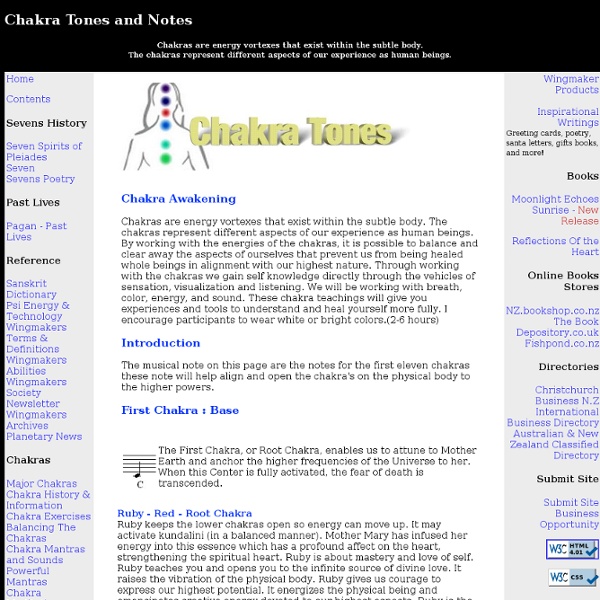Seven Major Chakra Series - Learn about the Root Chakra
root chakra | sacral chakra | solar plexus chakra | heart chakra | throat chakra | brow chakra | crown chakra The Base or Root Chakra is associated with the color red. This chakra is the grounding force that allows us to connect to the earth energies and empower our beings. Focusing one's attention on the color of a cherry popsicle or a juicy red apple can help bring our energetic body "down to earth" and in alignment with our physical body when we find ourselves energetically fleeting or in other words....."spacing off. Chakra One - Associations Learning About Chakras Are You Adequately Grounded? Bibliography: Anatomy of the Spirit by Caroline Myss, Flower Essence Repertory by Patricia Kaminski and Richard Katz, Hands of Light by Barbara Ann Brennan, Love is in the Earth by Melody
Description of the Chakras
Written by © Ewald Berkers What chakras are and their psychological properties Chakras are centers of energy, located on the midline of the body. There are seven of them, and they govern our psychological properties. The chakras can have various levels of activity. Ideally, all chakras would contribute to our being. There exist lots of techniques to balance the chakras. . 1 - Root chakra The Root chakra is about being physically there and feeling at home in situations. If you tend to be fearful or nervous, your Root chakra is probably under-active. If this chakra is over-active, you may be very materialistic and greedy. . 2 - Sacral chakra The Sacral chakra is about feeling and sexuality. If you tend to be stiff and unemotional or have a "poker face," the Sacral chakra is under-active. If this chakra is over-active, you tend to be emotional all the time. . 3 - Navel chakra The Navel chakra is about asserting yourself in a group. . 4 - Heart chakra . 5 - Throat chakra . 6 - Third Eye chakra
Harmonic Keyboard: Frequencies of the Human Body
This page is mirrored from Barbara Hero's inspiring, impressive, awesome website. December 21, 1997 Copyright © Barbara Hero 1996-98 E-Mail Barbara Hero Web Pages Designed and Produced by: R. M. Norley.
Encyclopedia Britannica
Magic Familiar-Chakras
The second chakra is known as the sacral plexus chakra spleen chakra or sexual chakra. It is situated in the lower abdomen behind and approximately two inches from the belly button, in the area of the womb. The chakra is represented by the orange Svadhistthana mandala (ones own place), the element of water and it is also symbolised by a fish. It is the source of creativity and inspiration. The second chakra is the foundation of the emotional body, it influences our ability to feel emotions, sensations and atmospheres, and controls our ability to let go of our emotions. The second chakra influences our sexuality and sensuality, physical force, sexual and ardent love, open-mindedness, our ability to yield and cooperating amicably with other people. If this chakra is not working properly it cause negative influences in the physical, this is seen in the form of emotional problems or sexual guilt, and excesses in food, sex and drugs.
The 13 Chakra System | OneHealsOne
What Is A Chakra - Chakras are energy centres in our bodies. They are the openings for 'life energy' to flow in and out of our aura. Their function is to nourish and vitalise our physical body and aid awareness to the development of our consciousness. How do we activate the chakras? We can activate our chakras through the breath, through yoga postures, meditation and prayers, through sound and colour, through singing, through visualisation, and through certain kinds of music. Aura We often hear expressions like “she has a nice aura”, or “he has good energy”. Gateways to consciousnessPsychologist Carl Jung called the chakras the "gateways of consciousness". Phi Ratio and Sacred Geometry Of The Chakras - It has long been known that the Phi Ratio, or Divine Proportion, appears in certain proportions of living organic life, Leonardo Da Vinci’s ‘canon man’ is famous for depicting the phi ratio in the human body. © Copyright 2011 Sarah Livesey
Transnational Institute
Solar Plexus Chakra Healing for Beginners - Our Intro Guide to the 3rd Chakra, the Solar Plexus Chakra
The 3rd Chakra, the Solar Plexus Chakra, represents our ability to be confident and in control of our lives. Here's what you need to know about Solar Plexus Chakra healing: Location of our Solar Plexus Chakra: Upper abdomen in the stomach area. Emotional issues affecting our Solar Plexus Chakra: Self-worth, self-confidence, self-esteem. Color: Yellow Healing Exercises: Kundalini Yoga, Boat Pose (image above)Dancing. Healing Foods: Yellow colored foods (corn)Grains and fiber (granola, whole wheat bread)Teas (peppermint, chamomile tea)
Sociological Research Online
Opening Your Third Eye
The Activation, Its Passive Usage Two exercises are given below: Mirror Watching A Single Person Watch your face in a mirror, with dimmed light. Make sure you are alone, or you know that no one will interrupt you, as you have to slip into a very relaxed state of consciousness, where any physical interruption may affect you much deeper. Choose maybe an evening, not a special time, but maybe after work, when you are perhaps already a bit tired physical and mentally. Again, watch your face, relax yourself by a calming suggestion such as, "I'm in peace within myself, I simply watch my face to calm and find peace in me". Don't move with your sight or blink your eyes, because it's necessary to allow your attention to move away from your physical eyes toward your inner eye. Choose a point on your face you focus, and don't change it anymore. The warmth is energy, which you attract by refocusing your attention. You have to release the attention to watch with your physical eyes.



